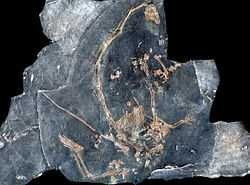Tanystropheus
| Tanystropheus Temporal range: Middle Triassic, 245–228Ma | |
|---|---|
 | |
| T. longobardicus fossil | |
| Scientific classification | |
| Kingdom: | Animalia |
| Phylum: | Chordata |
| Class: | Reptilia |
| Order: | †Protorosauria |
| Family: | †Tanystropheidae |
| Genus: | †Tanystropheus |
| Species | |
| |
| Synonyms | |
| |
Tanystropheus (Greek τανυς “long” + στροφαηυς “vertebra”), was a 6 metre (20 ft) long reptile that dated from the Middle Triassic period. It is recognizable by its extremely elongated neck, which measured 3 metres (10 ft) long - longer than its body and tail combined. Despite this length, it had only ten neck vertebrae, each quite long. Fossils have been found in Europe, the Middle East and China. Complete skeletons of juvenile individuals are most abundant in the Besano Formation of Italy, dating to 232 million years ago during the middle Triassic period (Ladinian stage).[1]
Paleoecology


With its incredibly long but relatively stiff neck, Tanystropheus has been often proposed and reconstructed as an aquatic or semi-aquatic reptile, a theory supported by the fact that the creature is most commonly found in semiaquatic fossil sites wherein known terrestrial reptile remains are scarce. Tanystropheus is most often considered to have been piscivorous (fish-eating'), due to the presence of a long, narrow snout sporting sharp interlocking teeth. In several young specimens, three-cusped cheek teeth are present in the jaw, which might indicate an insectivorous diet; however, similar teeth patterns have been found in Eudimorphodon and Langobardisaurus, both of whom are considered piscivores. Additionally, hooklets from cephalopod tentacles and what may be fish scales have been found near the belly regions of some specimens.[citation needed]
In 2006, Dr. Silvio Renesto described a specimen discovered in Switzerland which preserved the impressions of skin and other soft tissue. Renesto interpreted this specimen as supporting the hypothesis that Tanystropheus lived along the shoreline, snatching fish and other marine life from the shallows with its long neck and sharp teeth. The specimen displayed an unusual "black material" around the base of the tail, containing several calcium carbonate spherules, suggesting a quite noticeable amount of muscle behind the animal's hips. In addition to containing powerful hind limb muscles, this unusually large muscle mass would have shifted the animal's weight to its rear, stabilizing the animal as it swung and maneuvered its massive neck.[2]
The skin impressions are the first reported from Tanystropheus, showing that it was covered in semi-rectangular, non-overlapping scales.[2]
Classification

Tribelesodon, originally considered to be a pterosaur by Francesco Bassani in 1886, is now recognized as a junior synonym to Tanystropheus. The best-known species is Tanystropheus longobardicus. Other currently recognized species include T. conspicuus and T. meridensis.[3] Another junior synonym of Tanystropheus is Procerosaurus. Two specimens were initially identified as Procerosaurus: The first was described as P. cruralis by von Huene in 1902. The second was described by Antonin Fritsch in 1878 as a species of Iguanodon (Iguanodon exogirarum, later amended to exogyrarum), and is a highly doubtful dinosaurian-like bit of bone (possibly an internal cast of a tibia) from the Cenomanian (Late Cretaceous) of the Czech Republic. He reassigned the species to Procerosaurus in 1905 intending to erect it as a new genus, unaware that the genus name was already in use. George Olshevsky in 2000 substituted Ponerosteus for this species.
In 2002, fossils of a related genus, Dinocephalosaurus, were collected in marine Triassic deposits in southwestern China. This new creature was 2.7 metres (8.9 ft) long, 1.7 metres (5.6 ft) of which was its neck and head. The specimen was described in 2004.
See also
References
- ↑ Dal Sasso, C. and Brillante, G. (2005). Dinosaurs of Italy. Indiana University Press. ISBN 0-253-34514-6, ISBN 978-0-253-34514-1.
- ↑ 2.0 2.1 Renesto, S. (2005). "A new specimen of Tanystropheus (Reptilia Protorosauria) from the Middle Triassic of Switzerland and the ecology of the genus." Rivista Italiana di Paleontologia e Stratigrafia, 111(3): 377–394.
- ↑ Tanystropheus. Vertebrate Palaeontology at Milano University. Retrieved 2007-02-19.
- George Olshevsky expands on the history of "P." exogyrarum, on the Dinosaur Mailing List
- Huene, 1902. "Übersicht über die Reptilien der Trias" [Review of the Reptilia of the Triassic]. Geologische und Paläontologische Abhandlungen. 6, 1-84.
- Fritsch, 1905. "Synopsis der Saurier der böhm. Kreideformation" [Synopsis of the saurians of the Bohemian Cretaceous formation]. Sitzungsberichte der königlich-böhmischen Gesellschaft der Wissenschaften, II Classe. 1905(8), 1-7.